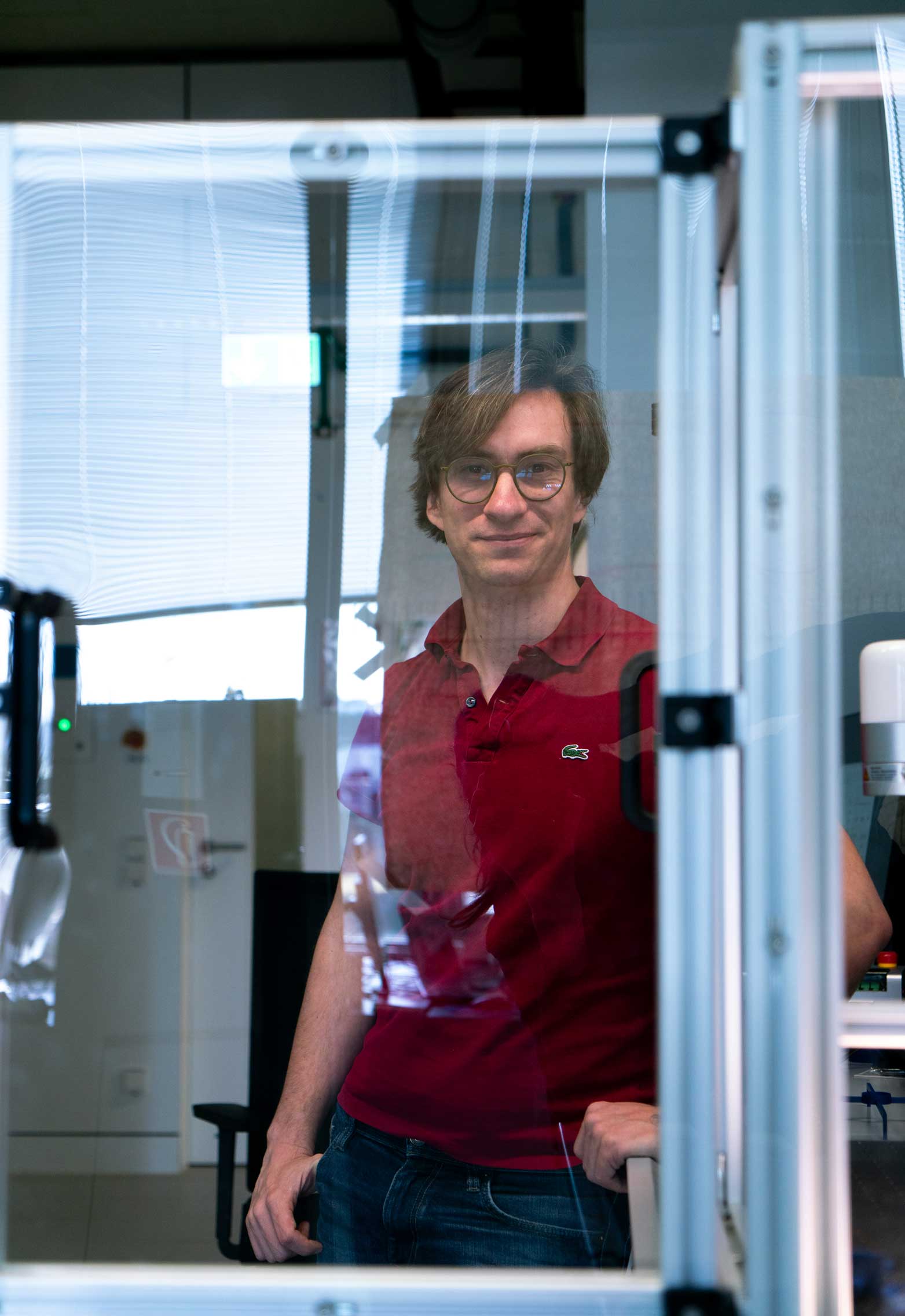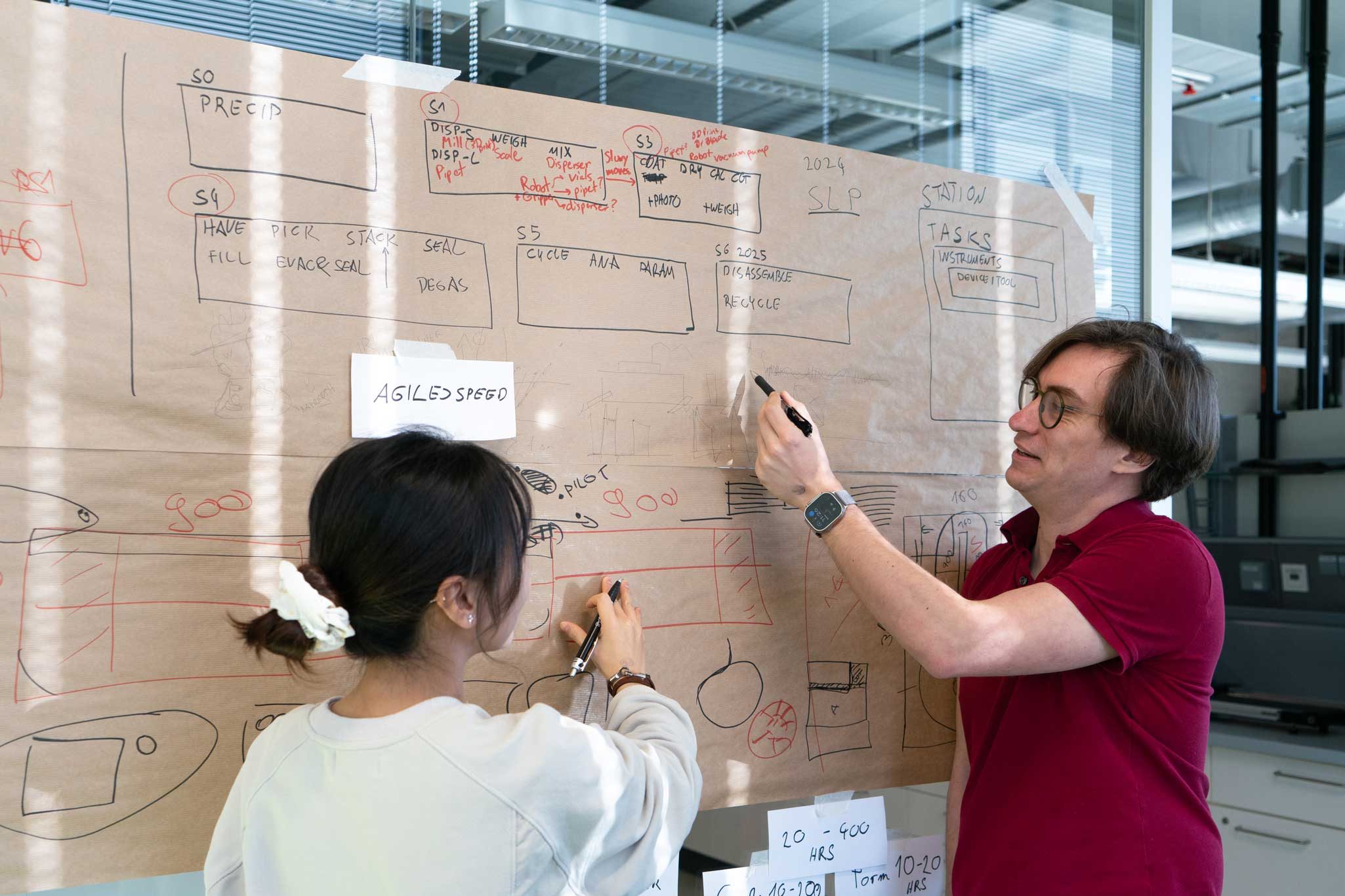
Prof. Helge Stein works at the interface of automation, electrochemistry and artificial intelligence. (Photo: V. Hiendl/TUM)
Why is it worth automatically producing a hundred batteries a day in the lab? How do you manage data efficiently? How do you teach computers chemistry? It’s questions like these that fascinate Helge Stein, a new researcher at the e-conversion Cluster of Excellence. Since mid-2023, the Hamburg native has been contributing his wealth of experience as Professor of Digital Catalysis. The physicist is building a high-tech facility at the Garching research campus of the Technical University of Munich (TUM) to take materials research for the batteries of tomorrow to a new level.
What does your research focus on?
For a successful transition of energy, transmission and heating systems we need innovative and powerful batteries and catalysts for the chemical industry. The key to this lies in materials research, which is what my team of now almost thirty scientists is working on. We conduct research at the interface of automation, electrochemistry and artificial intelligence. The primary goal of our research is to find new materials, but also new research processes. We intend to achieve this by having robots produce and characterize the materials. So, we are not primarily synthesizing materials, we are synthesizing data. By using statistical learning – or machine learning, which is the more up-to-date term – we can significantly accelerate the gain in knowledge.
What’s the process for unlocking this knowledge?
Batteries are basically composed of an anode, cathode, and electrolyte, as well as so-called “inactive” components. The latter ones consist of formulations and are the result of a production process. To use a cooking analogy, we are not just optimizing one ingredient, not just one recipe, but entire 10-course menus and the processes in the kitchen all at the same time. We therefore have a huge number of starting points for combining the right ingredients with the right methods. It’s about compiling individual components, but also about how they are brought together through different processes. In battery production, parameters may vary that you don’t immediately think about, so it can happen that you lose track. Applying machine-learning methods can help us find our way through this ever-growing jungle of data.
And that is where automation comes in …
Exactly! It would take way too long to build and test so many different batteries and catalysts using traditional manual laboratory methods. Robots can perform these tasks at a much faster pace than humans. For comparison, PhD students build and test around 100 to 300 button cells during their three or four years of research. Our robotics line at the Helmholtz Institute in Ulm can do that in one day. I am currently setting up a similar line at TUM for pouch cells. At each step of the process, data such as photos and videos will be generated automatically. So we will get a lot of information about the entire development history of a battery, then measure its performance and use all of this for our research.
How do you link the robot with artificial intelligence?
We transform the lab into a kind of digital twin and pass on the overall and partial optimization to a self-learning system. If we want to change a component or the composition of the battery or a reactor, the system can then provide an estimation of success and uncertainty. If we ask the system clever questions, we can significantly reduce the total number of experiments. This can be achieved, for example, by quantifying uncertainty. In other words, we ask the prediction models how sure they are about the outcome. You learn more if you sometimes also go to the points with high uncertainty. We generally take a hybrid approach, i.e. the robot performs repetitive processes, and we take care of complex tasks or processes which are non-critical in terms of integration.
Brief profile
Helge Stein studied physics at the University of Göttingen from 2008 to 2013. In 2017, he received his doctorate in mechanical engineering from Ruhr University Bochum for his research in high-throughput methods. Subsequently, he obtained a postdoctoral position at the California Institute for Technology (USA), where he worked as a materials data engineer at the Joint Center for Artificial Photosynthesis (JCAP). In 2020, he took up a tenure track professorship in applied electrochemistry at the Karlsruhe Institute of Technology. He was appointed Professor of Digital Catalysis at the Technical University of Munich in mid-2023.

Digitalization is the backbone of Helge Stein’s research, but he likes discussing ideas with his team members like PhD student Jun Juan on classical paper. (Photo: V. Hiendl/TUM)
What are the biggest advantages of artificial intelligence for your research?
I would rather describe it as skillful data processing. That’s closer to what we do. The great thing is that, unlike the lab notebooks of the past, many research processes are now digitalized, so that measurement data is continuously stored in the background. Digital data management is extremely beneficial because data can become FAIR (Findable, Accessible, Interoperable, Reusable) as a byproduct – which not only makes it more accessible and searchable but also helps us to identify trends and provide fresh impetus for research. My vision is an integrated data generation and analysis platform, i.e. a completely digitized system that brings together synthesis, characterization and analysis. As researchers, we are basically moving into uncharted territory and trying to explore a chemical map in absolute darkness. When we conduct experiments we collect random samples, thereby obtaining only a small section of a specific region. With the help of robotics and artificial intelligence, however, we are able to draw a clearer picture. It’s like flying in a helicopter to get a better overview and being able to zoom in with a telephoto lens when things get interesting.
Have you discovered anything exciting yet?
For the record, today’s batteries are already very good and the improvements in terms of capacity over the past 15 years have been tremendous. Materials scientists have really achieved a lot. But of course there is continuous progress. We found an electrolyte formulation that is two times more conductive at low temperatures, for example. This is very helpful if you want to charge your electric car at minus 10° C. We are also able to accelerate one step in the production of battery cells in gigafactories: the formation of the battery cell. It’s the very last step and quite time-consuming compared to the battery’s construction, but also very important. The process involves the initial charging of the newly assembled battery, during which important interphases are formed between the components, which are crucial for the performance and service life of the battery. This process takes 20 to 24 hours. We developed a technique called pulsed charging, which shortens this step to less than 10 hours. At the same time, the technique allows each cell to be kept on its individual optimal formation route, which significantly enhances its quality. We have already filed a patent for this idea. During my time in the USA, we found some very active and stable catalysts for water splitting at pH 0 and patented many discoveries in the field of AI. We continuously find new and unexpected things, and whenever the patenting office of our university greenlights or discards things, we move on with patents, publications or put the data in the system for others to look at.
You are in the middle of setting up your lab with an important piece of equipment arriving today. That requires a lot of energy and perseverance. What drives you and how do you recharge?
That’s right. A lot of things are not yet in place. We are currently setting up the equipment for the automated production of pouch cells. What I really like is the diversity of my research work and team and that it’s relatively application-oriented. I find it very motivating when an idea is quickly turned into a product. Our findings in the lab can be produced on an industrial scale in just 6 months. Creativity and versatility are important to me, and I also try to pass this on to my PhD students. I am convinced that with our toolbox – automation and AI – we can significantly accelerate materials research. I think by a factor of 10 to maybe even 100. Besides work my wife and I do a lot of recreational sports and cultural activities. We have recently discovered Krav Maga as a recreational activity alongside travel. Since I have switched completely from driving a car to using my bike and public transport, I can combine my bike training with my commute to Garching. My goal is to break the 7,000 km mark again this year. (Author: Caroline Zörlein)
Thank you very much for the interesting interview. We wish you all the best and every success in your research at TUM and e-conversion!
